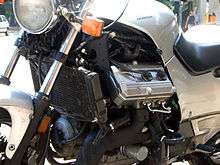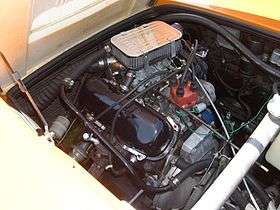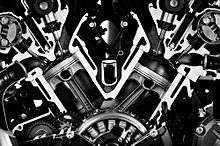V4 engine
A V4 engine is a four-cylinder piston engine where the cylinders share a common crankshaft and are arranged in a V configuration.

V4 engines are much less common than inline-four engines, however V4 engines have been used at times in automobiles, motorcycles and other applications.
Design
Most V4 engines (except for the two Ford engines) have two crankpins that are shared by opposing cylinders. The crankshaft is usually supported by three main bearings.
Compared to the more common inline-four engine layout, the advantages of the V4 include a shorter length and— when a 90-degree V-angle is used with the optimal firing interval— perfect primary balance which reduces vibration.[1] The design can also result in a smaller rocking couple than an inline-four engine, and the shorter crankshaft is less susceptible to the effects of torsional vibration due to its increased stiffness.
A disadvantage of V4 engines is that it requires two cylinder heads and exhaust manifolds (rather than only one each for an inline-four engine),[2] which increases cost and complexity. V4 engines are also wider than inline-four engines and it can be more difficult to incorporate ancillaries, inlet systems and exhaust systems while maintaining a compact size. Although a 60-degree V4 engine is more compact than a 90-degree V4 engine, the 60-degree design does not have perfect primary balance and therefore often requires a balance shaft to reduce vibrations.
Automobile use

The earliest automotive use of V4 engines were in Grand Prix racing (later called 'Formula One') cars. One of the pioneering V4 engines was in the 1898 Mors rear-engined car built in France.[3][4]At the time, the lack of vibration from the V4 engine was a key selling point,[5] however by 1901 the V4 engine was replaced by a conventional inline-four engine.
In the 1907 French Grand Prix, the car entered by J. Walter Christie used a 19,891 cc (1,214 cu in) V4 engine, the largest engine ever used in a Grand Prix race.[6] The engine was mounted transversely in the front and the car was front-wheel drive. The car retired from the French Grand Prix after just four laps, however it later set a speed record of 164 km/h (102 mph).[7]
The first V4 engine used in production cars was the Lancia V4 engine, which was first used in the 1922 Lancia Lambda.[8] The Lancia engine was a narrow-angle design with an angle of 20 degrees between the banks and a single cylinder head with one overhead camshaft shared by both banks. It also used an aluminium construction for both the block and head (which was rare for the time).[9] Lancia produced V4 engines until 1976, when they were replaced by flat-four engines.
The 1960-1994 ZAZ Zaporozhets was a Ukrainian city car which used a rear-mounted V4 engine.[9] This engine— based on the engine used in the LuAZ-967 amphibious militiary vehicle— was air-cooled with a magnesium block and was produced in displacements from 0.7–1.2 L (43–73 cu in).[10]
The AMC Air-cooled 108 was a 108 cu in (1.8 L) built from 1960-1963 for use in the lightweight M422 Mighty Mite military vehicle.[11][12] The M422 was by Jeep in the United States and designed to be transported by helicopter.[13][14]
Beginning in the 1960s, Ford's European divisions produced two unrelated V4 engines.[9] The first was the Ford Taunus V4 engine, produced in Germany from 1962–1981. The Taunus was a 60-degree V4 engine with water cooling and overhead valves. Initially designed for use in front-engined cars, it was used in various Ford models and also used in the Saab 95, Saab 96 and Saab Sonett models. It was also used in the mid-engine Matra 530 sports car.[15][16][17] The second Ford V4 engine was the Ford Essex V4 engine, produced in the United Kingdom from 1965-1977 and used in several Ford Corsair, Capri, Consul, Zephyr and Transit models.[18] Although designed separately to the Taunus engine, the Essex also was a 60-degree V4 with water cooling, overhead valves and designed for use in front-engined cars/vans.
The Porsche 919 Hybrid LMP1 racing car used in the 2014–2017 seasons used a 2.0 L (122 cu in) 90-degree turbocharged V4 engine which was mid-mounted.[19]
Motorcycle use

One of the first motorcycles powered by a V4 engine was the 1931-1935 Matchless Silver Hawk built in the United Kingdom. The Silver Hawk used a narrow angle 16-degree V4 engine with a single cylinder head, pushrod valve actuation and air cooling.
The 1936-1938 Puch P800 was built in Austria for both civilian and military uses.[20] The P800 used a very wide-angle 170-degree V4 engine (therefore being close in appearance to a flat-four engine) with two cylinder heads and air cooling.[21]
V4 engines enjoyed particular popularity during the mid-to-late 1980s, especially in transverse-engined Honda motorcycles which had a 90-degree V4 engine with water cooling.[22]
The Majority of 2020 MotoGP manufacturers chose the V4 configuration for their bikes.
- Honda RC213V
- Ducati Desmosedici
- KTM RC16
- Aprilia - 90° V4 for 2020 season.
Yamaha & Suzuki retain the in-line 4 configuration
Other uses
In 1935, the Wisconsin Motor Manufacturing Company began producing petrol (gasoline) V4 engines for industrial, agricultural and stationary applications,[23] with several farm equipment manufacturers using the Wisconsin V4 enginess.[24] In 1968, the largest Wisconsin V4 engine was the V-465D with a displacement of 177 cu in (2.9 L) and a power output of 66 hp (49 kW) at 3000 rpm.[25] The company produced V4 engines until 2019.[26]
In the mid-1940s, Turner Manufacturing Co in the United Kingdom produced a diesel water-cooled V4 engine for industrial and marine uses. This engine was used in the 1949-1957 Turner Yeoman of England tractor.
Mitsubishi Heavy Industries built the 4ZF, an air-cooled diesel-powered V4 engine used in the Type 73 Armored Personnel Carrier and related Japanese military vehicles since 1973.[27][28]
Another use of the V4 engine is in outboard motors for boats. They are usually two-stroke engines with a carburetor. Some of the largest manufacturers are Johnson, Evinrude, and Yamaha. V4 engines are popular in this application due to their short length.
See also
References
- Dusil, Tomáš (17 May 2017). "Automobilový vidlicový čtyřválec (V4): Proč se skoro nepoužívá? - Auto.cz". AUTO.CZ (in Czech). Retrieved 20 March 2018.
- Torchinsky, Jason. "Why Are V4 Engines So Rare?". Jalopnik. Retrieved 20 March 2018.
- "Grand Prix Cars - Mors 60 HP". www.grandprixhistory.org. Retrieved 7 December 2019.
- "MORS". www.brighton-early.com. Archived from the original on 9 December 2004.
- "The Mors Motor-Car". The Automotor and Horseless Carriage Journal: 272–273. March 1897.
- "Top 10, motores V4 como el de Porsche en Le Mans". Revista CAR: coches y actualidad del mundo del motor (in Spanish). 17 July 2017. Retrieved 20 March 2018.
- "Walters V4". www.klassiker.nu (in Swedish). 30 October 2018. Retrieved 7 December 2019.
- "100 Years of Motoring". The Motor: 52. 25 May 1985. Retrieved 20 March 2018.
- "Obsolete Engines 101: The Mythical "V4"". Car Throttle. 10 September 2009. Retrieved 19 July 2012.
- Baldwin, Nick (1987). The World guide to automobile manufacturers. Facts on File Publications. p. 530. ISBN 9780816018444. Retrieved 20 March 2018.
- "Mighty Mite M422". 4WD Online. Archived from the original on 16 July 2011. Retrieved 20 March 2018.
- Morr, Tom (1 January 2013). "1961 AMC M422A1 Mighty Mite - Tin Soldier". Four Wheeler Network. Retrieved 20 March 2018.
- "AMC M422 Mighty Mite Jeep (1959-62)". www.motor-car.net. Retrieved 7 December 2019.
- "Ranking The Best And Weirdest Engines Ever Made By Jeep". www.autowise.com. Retrieved 7 December 2019.
- Cole, Lance (2011). SAAB 99 & 900: The Complete Story. Crowood. ISBN 9781847973528. Retrieved 20 March 2018.
- McCourt, Mark J. (December 2017). "1971 Saab 96 V4: A Ford-sourced engine gave this Swede a new lease on life". Hemmings Motor News. Retrieved 20 March 2018.
- Henshaw, Peter (2004). Sports Cars: 500 Series. MBI Publishing. p. 178. ISBN 9780760319956. Retrieved 20 March 2018.
- Lee, Peter (2015). Ford Transit: Fifty Years. Crowood. ISBN 9781847978745. Retrieved 20 March 2018.
- "Porsche starts in Le Mans with four works cars". Porsche AG. 13 January 2014. Retrieved 16 February 2014.
- "Austrian Motorcycles". Classic Motorcycles by Sheldon's Emu (in Spanish). Retrieved 8 December 2019.
- "Puch P800". www.motos-of-war.ru. Retrieved 8 December 2019.
- "Historical V4's". Honda Media Newsroom. American Honda Motor Co. Archived from the original on 23 February 2014. Retrieved 17 February 2014.
- Swanson, David (2003). "Early History Of The Wisconsin Motor Company". Wisconsin Motors Canada. Retrieved 14 January 2016.
- "Wisconsin Motors advertisement". Product Engineering. 32: 415. 1961. Retrieved 14 January 2016.
- "Wisconsin Motors Corp". Automotive Industries. 138: 64. 1968. Retrieved 14 January 2016.
- "Engine: W4-1770". www.wiengines.com. Archived from the original on 17 February 2019.
- "Type 75 Multiple Launch Rocket System". www.military-today.com. Retrieved 8 December 2019.
- "Type 75 MLRS 130mm Multiple-Launch Rocket System - Japan". www.militaryfactory.com. Retrieved 8 December 2019.
| Wikimedia Commons has media related to V4 engines. |